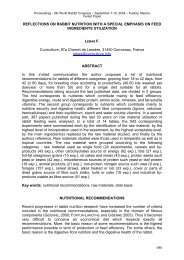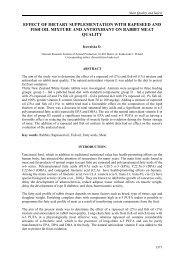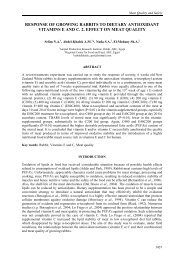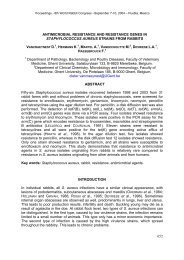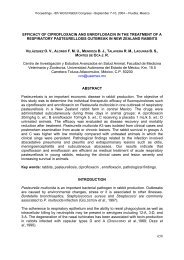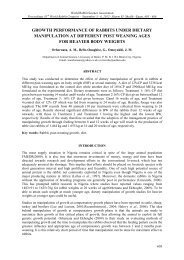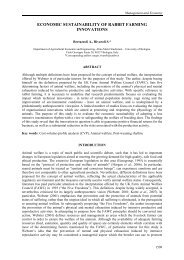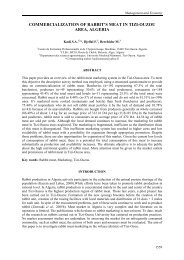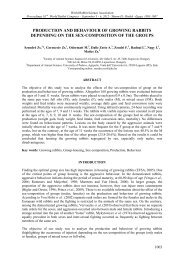review on rex rabbit breeding in china - World Rabbit Science ...
review on rex rabbit breeding in china - World Rabbit Science ...
review on rex rabbit breeding in china - World Rabbit Science ...
Create successful ePaper yourself
Turn your PDF publications into a flip-book with our unique Google optimized e-Paper software.
Genetics<br />
REVIEW ON REX RABBIT BREEDING IN CHINA<br />
Chen Baojiang*, Gu Zil<strong>in</strong>, Sun L<strong>in</strong>a, Huang Yut<strong>in</strong>g, Li Sufen, Liu Yajuan,<br />
Wang Lei, Zhao Chao, J<strong>in</strong>g Cui<br />
Mounta<strong>in</strong> Research Institute of Hebei Agricultural University Baod<strong>in</strong>g Ch<strong>in</strong>a, 071001<br />
*Corresp<strong>on</strong>d<strong>in</strong>g author: shyxq@hebau.edu.cn<br />
ABSTRACT<br />
This article outl<strong>in</strong>es the c<strong>on</strong>cepts of the Rex <strong>Rabbit</strong> variety and stra<strong>in</strong> and po<strong>in</strong>ts out the present<br />
situati<strong>on</strong> of the Rex <strong>Rabbit</strong> stra<strong>in</strong> <strong>in</strong> Ch<strong>in</strong>a. Six ma<strong>in</strong> problems of Rex <strong>Rabbit</strong> <strong>breed<strong>in</strong>g</strong> <strong>in</strong> Ch<strong>in</strong>a are<br />
exam<strong>in</strong>ed, e.g. pay<strong>in</strong>g more attenti<strong>on</strong> to weight, growth, the length of hair, the back hair, phenotypic<br />
trait and adulthood but ignor<strong>in</strong>g wholesome coord<strong>in</strong>ati<strong>on</strong>, hair quality, other aspects, other parts,<br />
hereditary basis and other growth stage; three k<strong>in</strong>ds of simple selective <strong>breed<strong>in</strong>g</strong> methods of Rex<br />
<strong>rabbit</strong> are proposed <strong>in</strong> this paper, e.g. synthesis, comprehensive selective <strong>in</strong>dex and simple selective<br />
<strong>breed<strong>in</strong>g</strong> table method.<br />
Key word: Rex <strong>rabbit</strong>, Problem of Rex <strong>rabbit</strong> <strong>breed<strong>in</strong>g</strong>, Selective <strong>breed<strong>in</strong>g</strong> method.<br />
INTRODUCTION<br />
The <strong>breed<strong>in</strong>g</strong> and rear<strong>in</strong>g of Rex <strong>Rabbit</strong> has good development potential <strong>in</strong> Ch<strong>in</strong>a. Many farmers and<br />
enterprises are participat<strong>in</strong>g <strong>in</strong> the Rex <strong>Rabbit</strong> producti<strong>on</strong> <strong>in</strong>dustry.<br />
The quality of the Rex <strong>Rabbit</strong> variety is <strong>on</strong>e of the most important factors c<strong>on</strong>tribut<strong>in</strong>g to this<br />
<strong>in</strong>dustrial development. Therefore, more attenti<strong>on</strong> is be<strong>in</strong>g paid <strong>on</strong> the Rex <strong>Rabbit</strong> selective <strong>breed<strong>in</strong>g</strong><br />
sector. Some remarkable achievements had been made dur<strong>in</strong>g last few years (Yang Li-p<strong>in</strong>g et al.,<br />
2000; Gu Zi-l<strong>in</strong>, 2006). But <strong>on</strong> the whole, there still exists some problems <strong>in</strong> the selective <strong>breed<strong>in</strong>g</strong> of<br />
Rex <strong>Rabbit</strong>. The authors put forth some of their <strong>in</strong>dividual views <strong>in</strong> these areas.<br />
Varieties<br />
VARIETIES AND STRAINS<br />
Breed<strong>in</strong>g of variety is the result of artificial selecti<strong>on</strong> and cultivati<strong>on</strong>, and each variety possesses<br />
specific biological characteristics. The different varieties provide the different product type of the<br />
livestock. There are two ma<strong>in</strong> varieties of Ch<strong>in</strong>ese domestic <strong>rabbit</strong>s: the meat variety and the fur<br />
variety. Each variety must possess the follow<strong>in</strong>g characteristics:<br />
- same orig<strong>in</strong> : each breed should have the same orig<strong>in</strong>. New Zealand white <strong>rabbit</strong> for example is the<br />
comm<strong>on</strong> ancestor of the American white <strong>rabbit</strong> and the Angolan <strong>rabbit</strong> while the comm<strong>on</strong> ancestor<br />
of Rex <strong>Rabbit</strong> are two <strong>in</strong>dividuals of the French meat <strong>rabbit</strong>;<br />
- stable heredity;<br />
- unique character and high product performance : the variety should have a unique characteristic<br />
feature e.g. hair, fur or meat, or high producti<strong>on</strong> performances and these must be passed down<br />
stably to the next generati<strong>on</strong>;<br />
- certa<strong>in</strong> structure : 3-5 stra<strong>in</strong>s should be established <strong>in</strong> each k<strong>in</strong>d of variety. Every stra<strong>in</strong> has its own<br />
characteristics features and the variety can be improved through thoroughbred <strong>breed<strong>in</strong>g</strong>;<br />
- enough quantity : there are 200-300 founder female groups <strong>in</strong> every stra<strong>in</strong> and 600-1500 founder<br />
females <strong>in</strong> every variety;<br />
- be recognized by the government or certa<strong>in</strong> Breed<strong>in</strong>g Community.<br />
57
9 th <strong>World</strong> <strong>Rabbit</strong> C<strong>on</strong>gress – June 10-13, 2008 – Ver<strong>on</strong>a – Italy<br />
Stra<strong>in</strong><br />
The stra<strong>in</strong> is the cell of variety. A variety is composed of certa<strong>in</strong> stra<strong>in</strong>s.<br />
The characteristics of stra<strong>in</strong> are as follows: Prom<strong>in</strong>ent features (such as hair density, weight,<br />
reproductive ability), relatively stable heredity; available <strong>in</strong> certa<strong>in</strong> quantity (200-300, female <strong>rabbit</strong>).<br />
Present situati<strong>on</strong> of Rex <strong>rabbit</strong> stra<strong>in</strong> <strong>in</strong> Ch<strong>in</strong>a<br />
DISCUSSION<br />
Past- Three k<strong>in</strong>ds of stra<strong>in</strong>s<br />
In Ch<strong>in</strong>a, the Rex <strong>Rabbit</strong> stra<strong>in</strong>s <strong>in</strong> the past referred to the American Stra<strong>in</strong>, German Stra<strong>in</strong> and French<br />
Stra<strong>in</strong>. However, based <strong>on</strong> the classificati<strong>on</strong> features above, it is difficult to classify them <strong>in</strong>to any<br />
type. In fact, the Rex <strong>Rabbit</strong>s <strong>in</strong> Ch<strong>in</strong>a were <strong>in</strong>troduced from different countries based <strong>on</strong> the needs at<br />
the time of import. From 1982 to 1983, two batches of Rex <strong>Rabbit</strong>s were <strong>in</strong>troduced to Hebei Prov<strong>in</strong>ce<br />
from US. Through our <strong>in</strong>vestigati<strong>on</strong>s and analysis we found that they were ma<strong>in</strong>ly from three <strong>rabbit</strong><br />
<strong>breed<strong>in</strong>g</strong> field of two states. In other Prov<strong>in</strong>ces the situati<strong>on</strong> was the same.<br />
The achievement of Rex <strong>rabbit</strong> stra<strong>in</strong> <strong>breed<strong>in</strong>g</strong><br />
After the <strong>in</strong>troducti<strong>on</strong> of Rex <strong>Rabbit</strong> from different countries, Ch<strong>in</strong>a also began to work <strong>on</strong> cultivat<strong>in</strong>g<br />
new stra<strong>in</strong> (Wang Shi-cheng et al., 2002; Wang Shi-cheng et al., 2001; Wang Shi-cheng et al., 2001,<br />
Fu feng-sheng et al., 2002) and new stra<strong>in</strong>s of Rex <strong>Rabbit</strong> were selected. Under the expert’s guidance,<br />
new Rex <strong>Rabbit</strong> stra<strong>in</strong>s were cultivated by Jiangsu J<strong>in</strong>gx<strong>in</strong>g Rex <strong>Rabbit</strong> company and the Grassland<br />
Research Institute of Sichuan Prov<strong>in</strong>ce (Xu Han-Tao and Yan H<strong>on</strong>g-sheng, 2001; Xu Han-Tao, 2004)<br />
and were respectively recognized by the nati<strong>on</strong>al council (Chen cheng-g<strong>on</strong>g et al., 1997; Fan Chengqiang<br />
et al., 2003). Many colleges, universities and research units are now <strong>in</strong>volved <strong>in</strong> <strong>rabbit</strong> <strong>breed<strong>in</strong>g</strong>.<br />
Thus more and better new stra<strong>in</strong>s of <strong>rabbit</strong>s can be expected <strong>in</strong> the near future.<br />
The present situati<strong>on</strong> <strong>in</strong> product <strong>rabbit</strong><br />
Ch<strong>in</strong>a's Rex <strong>Rabbit</strong> product performance has improved. But due to market fluctuati<strong>on</strong>s the profitability<br />
is unstable. Many <strong>in</strong>vestors had bl<strong>in</strong>dly jo<strong>in</strong>ed <strong>in</strong>to this field and suffered great losses. The ma<strong>in</strong><br />
reas<strong>on</strong> is that the Rex <strong>Rabbit</strong> stra<strong>in</strong> is not top-class and the product performance is poor.<br />
Many <strong>rabbit</strong> farmer often ask such questi<strong>on</strong>s like, “Which Rex <strong>rabbit</strong> stra<strong>in</strong> is good?” “Whose<br />
domestic Rex <strong>rabbit</strong> is good?”. Indeed, these are questi<strong>on</strong>s that need to be answered urgently to the<br />
farmers. The problem however is that it is difficult to answer. In fact, the stra<strong>in</strong>s <strong>in</strong> the most <strong>rabbit</strong><br />
<strong>breed<strong>in</strong>g</strong> plant are not pure. Usually they are the mixed-blood of the three old stra<strong>in</strong>s. Some <strong>rabbit</strong><br />
plants attach importance that the breed and stra<strong>in</strong> are comparatively pure. Others ignore this<br />
requirement result<strong>in</strong>g <strong>in</strong> low productivity. Rex <strong>Rabbit</strong> is unlike the meat <strong>rabbit</strong>, the hybridizati<strong>on</strong> is<br />
carried <strong>on</strong> <strong>in</strong> <strong>on</strong>ly <strong>on</strong>e variety. Therefore if the Rex <strong>Rabbit</strong> has excellent product performance this<br />
favorable characteristic will be <strong>in</strong>herited by its descendants.<br />
Problem about <strong>breed<strong>in</strong>g</strong> <strong>in</strong> Ch<strong>in</strong>a<br />
Both <strong>rabbit</strong> enterprises and scholars acknowledge the importance of research and experimental works<br />
<strong>on</strong> <strong>rabbit</strong> <strong>breed<strong>in</strong>g</strong>. However, <strong>in</strong> some areas there are misunderstand<strong>in</strong>gs <strong>in</strong> vary<strong>in</strong>g degrees.<br />
Pay more attenti<strong>on</strong> to weight but ignore the entirety coord<strong>in</strong>ati<strong>on</strong><br />
In the past, the ma<strong>in</strong> Rex <strong>Rabbit</strong> <strong>in</strong> our country was of the American stra<strong>in</strong>. The weight of this stra<strong>in</strong><br />
was light. The breeders therefore paid more attenti<strong>on</strong> <strong>on</strong> the weight growth and the weight of selected<br />
adult <strong>rabbit</strong> reached 4.5 kg, or even more than 5 kg. Many failed to realize that the Rex <strong>Rabbit</strong> bel<strong>on</strong>gs<br />
to medium-sized <strong>rabbit</strong> variety and when the weight exceeds certa<strong>in</strong> range, overall coord<strong>in</strong>ati<strong>on</strong> will<br />
58
Genetics<br />
sharply decl<strong>in</strong>e. This is especially so when it is vulnerable to diseases. Its productive life will be<br />
shortened.<br />
Pay more attenti<strong>on</strong> <strong>on</strong> growth but ignore hair quality<br />
In Ch<strong>in</strong>a, the value of Rex <strong>Rabbit</strong> is usually measured by its weight while the hair density and the fur<br />
quality were largely ignored. Many people just focused <strong>on</strong> the growth rate. After several generati<strong>on</strong>s<br />
of <strong>breed<strong>in</strong>g</strong>, there is a boost <strong>in</strong> the growth rate but the hair quality decl<strong>in</strong>es. If this situati<strong>on</strong> persists,<br />
the Rex <strong>Rabbit</strong> will merely become a meat <strong>rabbit</strong>.<br />
Pay more attenti<strong>on</strong> <strong>on</strong> the length of hair but ignore other aspects<br />
Presently the price of <strong>rabbit</strong> fur has In these years, the price of the Rex <strong>rabbit</strong> fur has risen and this is<br />
welcomed by the marketplace. So many pers<strong>on</strong>s will regard the length of hair as an important <strong>breed<strong>in</strong>g</strong><br />
<strong>in</strong>dex dur<strong>in</strong>g <strong>breed<strong>in</strong>g</strong> work. As l<strong>on</strong>g as the hair is l<strong>on</strong>g, the other traits were largely ignored. This <strong>on</strong>esided<br />
pursuit of hair length and neglect for a comprehensive characteristics development will have<br />
drawbacks <strong>on</strong> the development of Rex <strong>Rabbit</strong> farm.<br />
Pay more attenti<strong>on</strong> <strong>on</strong> the back hair but ignore the other parts<br />
Hair density, length, uniformity are three measurable <strong>in</strong>dicators of the hair quality. But hair from<br />
which part is the relevant po<strong>in</strong>t? It is thought that hair <strong>on</strong> the middle of back has str<strong>on</strong>g representati<strong>on</strong>.<br />
Therefore, to many people <strong>on</strong>ly the quality of the hair <strong>in</strong> the middle of the back is representative. But<br />
<strong>in</strong> fact when determ<strong>in</strong><strong>in</strong>g the quality of fur of Rex <strong>Rabbit</strong> the fur <strong>in</strong> all five parts (like the back, neck<br />
and abdomen) should be measured.<br />
Pay more attenti<strong>on</strong> <strong>on</strong> phenotypic trait but ignore the hereditary basis<br />
S<strong>in</strong>ce the <strong>breed<strong>in</strong>g</strong> c<strong>on</strong>diti<strong>on</strong> is quite dist<strong>in</strong>ct am<strong>on</strong>g each <strong>rabbit</strong> farm, there are significant differences<br />
<strong>in</strong> the phenotypic trait <strong>in</strong> <strong>in</strong>dividual farms. A basic pr<strong>in</strong>ciple of <strong>breed<strong>in</strong>g</strong> animals is the phenotype<br />
which is genotype and envir<strong>on</strong>ment. The purpose of selecti<strong>on</strong> is to f<strong>in</strong>d those phenotypic trait<br />
differences caused by genetic factors. For example, <strong>on</strong>e female <strong>rabbit</strong> may give birth to <strong>on</strong>ly <strong>on</strong>e while<br />
another eight. Rapid growth and development of the s<strong>in</strong>gle offspr<strong>in</strong>g does not necessarily meant the<br />
traits of the s<strong>in</strong>gle offspr<strong>in</strong>g are superior to that of the multiple offspr<strong>in</strong>g. If breed selecti<strong>on</strong> is <strong>on</strong>ly<br />
accord<strong>in</strong>g to the phenotype of <strong>in</strong>dividual, it will be very likely to draw the <strong>in</strong>dividuals which has most<br />
outstand<strong>in</strong>g phenotypic trait were selected.<br />
Pay more attenti<strong>on</strong> <strong>on</strong> adult but ignore other growth stage<br />
Very often when select<strong>in</strong>g <strong>rabbit</strong>s for <strong>breed<strong>in</strong>g</strong>, more attenti<strong>on</strong> is paid <strong>on</strong> the adult performance while<br />
the overall development is neglected. This is <strong>in</strong>appropriate as the performance of <strong>in</strong>dividual <strong>rabbit</strong> is<br />
affected differently at each stage of development.<br />
Breed<strong>in</strong>g method<br />
The Rex <strong>Rabbit</strong> <strong>breed<strong>in</strong>g</strong> is a systematic project. It needs not <strong>on</strong>ly theoretical foundati<strong>on</strong>, but also<br />
arduous labor. Under the theory guidance, some normal <strong>rabbit</strong> farm can carry out <strong>rabbit</strong> <strong>breed<strong>in</strong>g</strong><br />
activities. Accord<strong>in</strong>g to the author’s experience, if the culturist masters the genetic traits of Rex<br />
<strong>Rabbit</strong>s, he can apply simple methods to cultivate new stra<strong>in</strong>s and improve the quality of <strong>rabbit</strong>s<br />
group. Three simple selecti<strong>on</strong> methods are suggested.<br />
Synthesis of the three old stra<strong>in</strong>s<br />
The authors breed a hybrid us<strong>in</strong>g the three k<strong>in</strong>ds of stra<strong>in</strong> from 1996 and identified match<strong>in</strong>g pattern of<br />
the three stra<strong>in</strong>s. The synthesis is carried out as follows: firstly, American Rex <strong>rabbit</strong> (female) ×<br />
French Rex <strong>Rabbit</strong> (male); sec<strong>on</strong>dly, outstand<strong>in</strong>g female <strong>rabbit</strong>s of hybrid generati<strong>on</strong> × German Rex<br />
<strong>Rabbit</strong>. Through this method, the f<strong>in</strong>al offspr<strong>in</strong>g carries with it the advantageous traits of each of the<br />
three stra<strong>in</strong>s and this offspr<strong>in</strong>g is superior to any <strong>on</strong>e k<strong>in</strong>d of the three stra<strong>in</strong>s.<br />
59
9 th <strong>World</strong> <strong>Rabbit</strong> C<strong>on</strong>gress – June 10-13, 2008 – Ver<strong>on</strong>a – Italy<br />
Comprehensive selective <strong>in</strong>dex method<br />
Accord<strong>in</strong>g to the phenotype, heritability, ec<strong>on</strong>omic importance, and correlati<strong>on</strong> between phenotypic<br />
and genetic traits, we get the comprehensive selecti<strong>on</strong> <strong>in</strong>dex formula as follows:<br />
In the formula:<br />
Wi is the ec<strong>on</strong>omy significance of trait i;<br />
h²i is the heritability of trait i,;<br />
W is the average value of trait i;<br />
Pi is the observed value of trait i;<br />
W i h i 2 P i<br />
I = ∑────── × 100<br />
Pi∑Wihi 2<br />
Simple selective <strong>breed<strong>in</strong>g</strong> table method<br />
The authors developed a simple selective <strong>breed<strong>in</strong>g</strong> score tables method for the Rex <strong>Rabbit</strong> (Table 1).<br />
Table 1: Score table of Rex <strong>Rabbit</strong><br />
Rank Index Grade Remarks<br />
Weight<br />
3.75~4.0( 2.5、 3.5)<br />
kg 30<br />
3.5~3.74(2.0、3.0) kg 25<br />
3~ 3.4(2.0、<br />
2.75) kg 20<br />
Body type Standard 20<br />
Qualified 15<br />
Low-graded 10<br />
Hair density ≥2.0 Ten thousand 30<br />
≥1.7 Ten thousand 25<br />
Hair length<br />
Hair smoothness<br />
≥1.3 Ten thousand 20<br />
1.8-2.2 20<br />
1.6-1.79 15<br />
90;<br />
sec<strong>on</strong>d-class:>85;<br />
third-class: >70;<br />
Can not be reserved:





